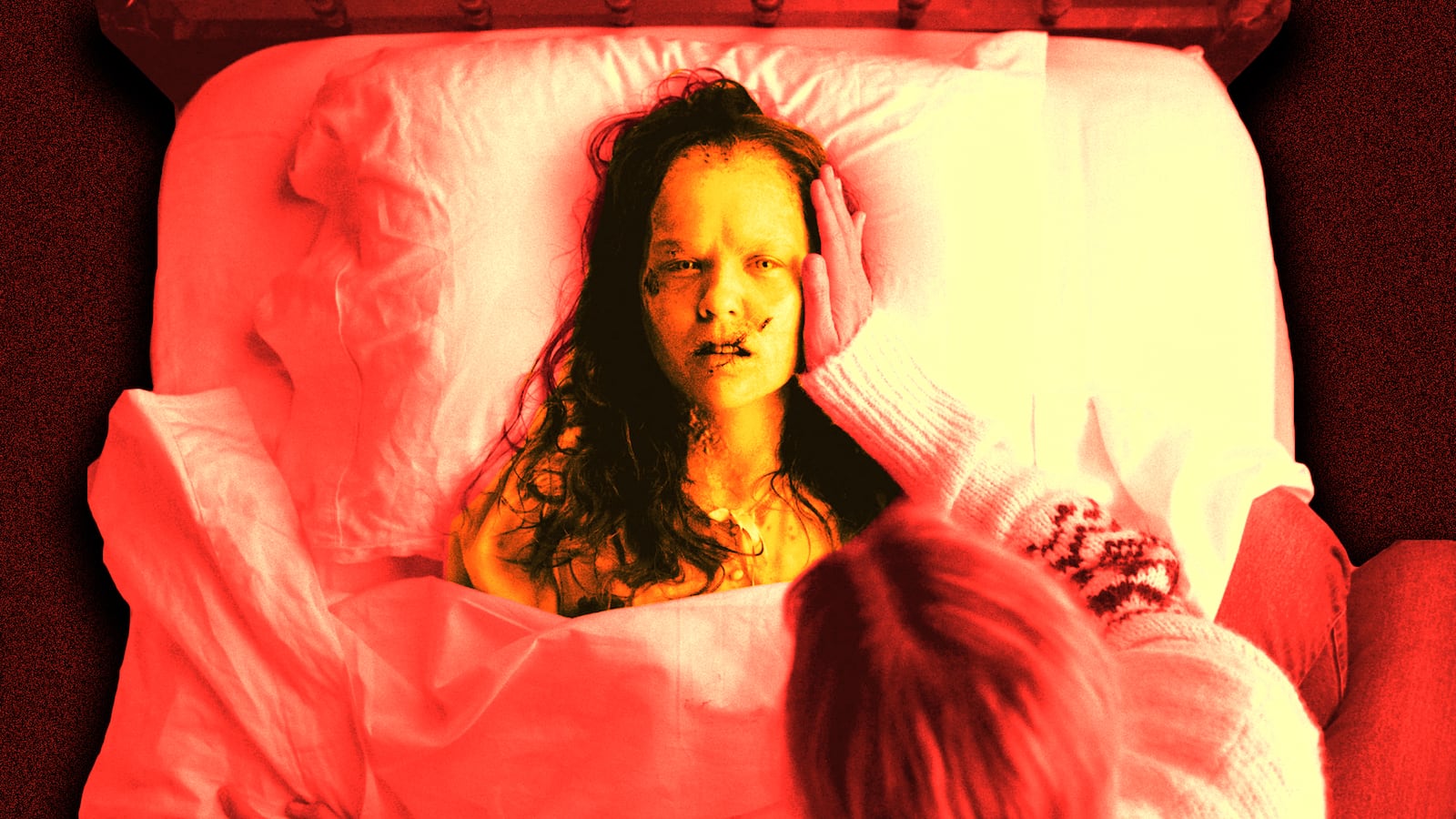As two of the masterminds behind Eastbound and Down, Vice Principals, and The Righteous Gemstones, Danny McBride and David Gordon Green are responsible for some of modern television’s most outrageously uninhibited and amusing comedies. Regrettably, their attempts to revitalize classic horror franchises—first with their recent trio of Halloween reboot-sequels, and now with The Exorcist: Believer, the initial installment of a planned trilogy—leave much to be desired. Rehashing with the aid of original series stars, their scary-movie ventures play like creatively unnecessary and uninspired IP extensions, and that goes double for their latest, which brings back Ellen Burstyn for a tale of possessed kids and tormented adults that, for all the wrong reasons, proves hellish.
As with his Halloween efforts, director Green’s The Exorcist: Believer (in theaters Oct. 6) is a direct follow-up to the franchise’s maiden entry; all pre-existing sequels have been erased from its fictional timeline. In Port-au-Prince, Haiti, photographer Victor Fielding (Leslie Odom, Jr.) takes snapshots on the beach as his pregnant wife shops at the market and is led by a child to a quasi-voodoo ceremony, where she receives “the most beautiful blessing of protection for Angela.” Unfortunately, while her unborn infant daughter is defended by a higher power, her mother isn’t, and in a subsequent earthquake, she’s critically hurt. Victor is told by doctors that he must choose between saving his spouse and his child—due to injuries that conveniently go unexplained—at which point the film cuts to present-day Percy, Georgia, where Victor is a single dad caring for middle-schooler Angela (Lidya Jewett).

Victor is close to Angela, if a bit clingy, and she considers it a triumph when she convinces him to let her stay out after school one evening with her friend Katherine (Olivia O'Neill), the pious daughter of devout Catholic parents Miranda (Jennifer Nettles) and Tony (Norbert Leo Butz). Once the bell rings, they wander off into the nearby woods, descend into a decrepit bunker-like structure, light candles, and begin a ritual designed to allow Angela to communicate with her deceased mother. When Victor returns home to discover that his daughter is MIA, he gets in touch with Miranda and Tony. After he hears that Katherine is also missing, he begins searching for the duo. Three days pass with no success, until some random farmer’s son stumbles upon them in a barn 30 miles from their last-known location, completely clueless about how they got there or how much time has passed.
This is a reasonably spooky set-up, and The Exorcist: Believer gets a bit of mileage out of Angela and Katherine’s early signs of demonic possession, which manifests itself in a local hospital where doctors note confoundedly that neither girl has suffered any physical harm. Green and co-writer Peter Sattler build dread at a suitable pace, but their dialogue is the pits—epitomized by a testy early conversation between Victor, Tony, and Miranda in which, while going over what the girls were doing in the woods, Miranda says, “That’s how demonic possession works!” As far as the film is concerned, this pronouncement suffices as the explanation for why these innocents have fallen victim to Satan, although simultaneously suggested is the idea that Angela’s grief over her dead mom has made her susceptible to supernatural forces—a notion that echoes the premise of this year’s superior Talk to Me.
Victor is a skeptic for reasons unknown; he has no faith even before his wife perishes. This puts him at odds with Miranda, Tony, and his neighbor Ann (Ann Dowd), a nurse who, expediently, once trained to be a nun and gives Victor a book about possession written by Chris MacNeil (Burstyn). In the aftermath of The Exorcist, Chris apparently became a best-selling author and traveled the world studying every religion’s form of exorcism. Victor seeks her out, and she immediately agrees to help him, thanks to the same photographs—of Angela’s stomach scars reading “Save Me”—that instantly dispelled the photographer’s doubts about God and the Devil. It’s easy-bake plotting of the most superficial sort. So too is how, when visiting Angela and Katherine, Chris promptly understands that this is the real deal courtesy of the girls’ taunts about her past and, in particular, her estranged relationship with her own daughter, Regan.

The Exorcist: Believer trots out Burstyn for continuity credibility, then treats her with stunning disrespect—the most brazen of many indications that the film is a soulless cash-in on an established name brand. That said, by being relegated to the sidelines, Burstyn is spared having to witness the pitiful exorcism climax performed by Victor, Miranda, Tony, Ann, and a group of papier-mâché nobodies. These include a wimpy priest, a featureless neighbor, and Dr. Beehibe (Okwui Okpokwasili), an oncologist-turned-spiritual guru whose tricks of the trade date back to the days of slavery. Green stages this centerpiece with maximum writhing, drooling, spitting, screaming, and wailing; bodies bend, limbs snap, and heads turn, with Angela and Miranda—their puffy faces covered in scratches and upside-down cross carvings—alternating between spewing profane filth and courting sympathy by pretending to be in agony.
Fifty years after the late William Friedkin’s The Exorcist terrified audiences with these devices, they’ve become the hoariest of genre clichés. The much-reviled Exorcist II: The Heretic at least tried to do something different, and The Exorcist III provided one of cinema’s all-time great jump scares. Green, on the other hand, fails to enliven what now amounts to a basic and familiar horror scenario. Odom, Jr. and Dowd vigorously emote, yet it’s all in service of second-rate multi-denomination mumbo-jumbo whose effectiveness hinges on ignorance of prior demonic-possession movies, and which culminates with a depressingly corny twist.

Green’s narrative preaches that evil can only be defeated if people unite as a community. The sole things tethering together this nightmare, however, are regurgitated bible quotes, dreary truisms and familiar sights of young girls in thrall to Beelzebub. Maybe there’s hope for the director’s forthcoming sequels, but my faith is gravely shaken.






